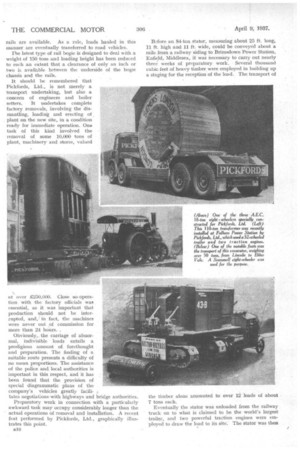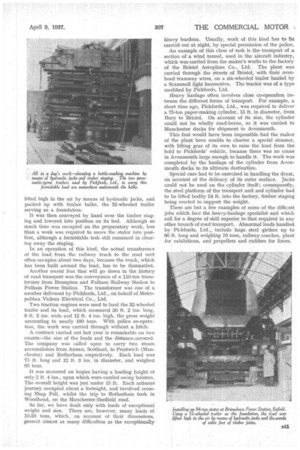THE SKY'S THE LIMI IN HEAVY HAULAGE
Page 42

Page 43

Page 44

Page 45

If you've noticed an error in this article please click here to report it so we can fix it.
Pickfords, Ltd., Uses Over 200 Units for the Transport of Abnormal Loads. Fleet Includes World's Largest Lorry and Trailer APART from revolutionizing distribution methods, the development of road transport, and particularly the heavy-haulage branch, has had a profound effect upon production costs in British industry. It is now possible to build machinery of dimensions that were impracticable when only rail transport was available, and the heavy expense of transporting large plant in sections and erecting it on site has been eliminated.
Much of the credit for this benefit to industry is due to Pickfords, Ltd., which is probably the world'Vlargest concern of abnormal-load specialists. At its heavyhaulage headquarters at 151, Tower Bridge Road, London, S.E.1, and its br'anches in Manchester, Birmingham, Sheffield, Bristol, Coventry, Leeds, Leicester, Lincoln and Southampton, the company is equipped to deal with any load that is capable of transport by road. The range of plant available is remarkable, and comprises over 200 units for the haulage of awkward loads.
After a period of many years, Pickfords, .Ltd., has again taken up heavy-haulage operation in the Sheffield area, by succeeding, on March 25, to the heavy-haulage department of Messrs. Coupe Bros., which has been established for nearly 100 years. The company originally worked in this territory, but some years ago disposed a8
of its heavy haulage interests in Sheffield to a firm, who, in turn, were absorbed by Messrs, Coupe Bros. Now it has revived its activities by buying out the heavyhaulage department of
• that firm.
Most of the transport equipment has had to be designed to meet the company's special requirements. Notable among the vehicles are three A.E.C. dropped frame eight-wheelers, which are capable of dealing with 18-ton pay-loads. Scamraell outfits of eight types, designed to cope with weights varying from .a. mere 25 tons up to 150 tons, figure prominently in the fleet. Except for the famous 100 ton 14wheeler (which can actually carry 150 tons), all the Scammells are eight-wheelers, the principal differences being in connection with the disposition of the rear wheels.
The trailers employed are mainly of Crane' and Dyson makes, although Pickfords, Ltd., builds a number of its own units. Available in a range of six different types, they are built to handle loads from 15 tons to about 150 tons. The largest trailer is a 32-wheeler, mounted on 84 solid rubber tyres. As is well known, it comprises two 16-wheeled bogies, upon which is mounted a massive steel platform. The appliance can be used as a unit, or the bogies can be employed separately, without the platform, for the accommodation of. exceptionally long loads.
On the steam side, there are 10 huge Fowler and other traction engines, which are used in tandem when dealing with burdens of exceptional weight.
Besides the road-transport plant, there are Ransomes and Rapier mobile cranes (Pickfords, Ltd., being the first company to employ this type of unit) and powerful cross-country track-laying tractors for haulage on sett ground.
Apart from road vehicles, the company utilizes a number of rail bogies for conveying unusually heavy loads into positions inaccessible by road. This work often entails the laying of rails on which to use the bogies, although they are frequently employed on the Central Electricity Board's grid sites, where permanent rails are available. As a rule, loads hauled in this manner are eventually transferred to road vehicles.
The latest type of rail bogie is designed to deal with a weight of 150 tons and loading height has been reduced
to such an extent that a clearance of only an inch or two is available between the underside of the bogie chassis and the rails.
It should be remembered that Pickfords, Ltd., is riot merely a transport undertaking, but also a concern of engineers and boiler setters. It undertakes complete factory removals, involving the dismantling, loading and erecting of . plant on the new site, in a condition ready for immediate operation. On task of this kind involved the removal of some 10,000 tons of plant, machinery and stores, valued at over £250,000. Close so-operation with the factory officials was essential, as it was important that production should not be interrupted, and,/ in fact, the machines were never out of commission for more than 24 hours. •
Obviously,, the carriage of abnormal, indivisible loads entails a prodigious amount of forethought and preparation. The finding of a suitable route presents a difficulty of no mean proportions. The assistance of the police and local authorities is important in this respect, and it has been found that the provision of special diagrammatic plans of the company's vehicles greatly facilitates negotiations with highways and bridge authorities.
Preparatory work in connection with a particularly awkward task may occupy considerably longer than the actual operations of removal and installation. A recent feat performed by Pickfords, Ltd., graphically illustrates this point.
1110
Before an 84-ton stator, measuring about 25 ft. long, 11 ft. high and U. ft. wide, could be conveyed about a mile from a railway siding to Brimsdown Power Station, Enfield, Middlesex, it was necessary to carry out nearly thret. weeks of preparatory work. Several thousand cubic feet of heavy timber were employed in building up a staging for the reception of the load. The transport of the timber alone amounted to over 12 loads of about 7 tons each.
Eventually the stator was unloaded from the railway truck on to what is claimed to be the world's largest trailer, and two powerful traction engines were employed to draw the load to its site The stator was then lifted high in the air by means of hydraulic jacks, and packed up with timber balks, the 32-wheeled trailer serving as a foundation.
It was then conveyed by hand over the timber staging and lowered into position on its bed. Although so much time was occupied on the preparatory work, less than a week was required to move the stator into position, although a formidable task still remained in. clearing away the staging.
In an operation of this kind, the actual transference of the load from the railway truck to the road unit often occupies about two days, because the truck, which has been built around the load, has to be dismantled.
Another recent feat that will go down in the history of road transport was the conveyance of a 110-ton transformer from Bronapton and Fulham -Railway Station to Fulham Power Station. The transformer was one of a number delivered by Picicfords, Ltd., on behalf of Metropolitan Vickers Electrical Co.,, Ltd.
Two traction engines were used to haul the 32-wheeled trailer and its load, which measured 20 ft. 2 ins. long, 9 ft. 3 ins, wide and 12 ft. 4 ins, high, the gross weight amounting to nearly 180 tons. With police co-operation, the work was carried through without a hitch.
A contract carried out last year is remarkable on two counts—the size of the loads and the distance, covered. The company was called upon to carry two steam accumulators from Annan, Scotland, to Prestwich (Manchester) and Rotherham respectively. Each load was 75 ft. long and 12 ft. 3 ins, in diameter, and weighed 65 tons.
It was mounted on bogies having a loading height of only .2 ft. 4 ins., upon. which were carried swing bolsters. The overall height was just under 15 ft. Each arduous journey occupied about a fortnight, and involved crossing Shap Fell, whilst the trip to Rotherham took in Woodhead, on the Manchester-Sheffield road.
So far, we have dealt only with loads of exceptional weight and size. There are, however, many loads of 10-20 tons, which, on account of their dimensions, present almost as many difficulties as the exceptionally
hbavy burdens. Usually, work of this kind has to lie carried out at night, by special permission of the police.
An example of this class of task is the transport of a section of a wind tunnel, used in the aircraft industry, which was carried from the maker's works to the factory of the Bristol Aeroplane Co., Ltd. The plant was carried through the streets of Bristol, with their Overhead tramway wires, on a six-wheeled trailer hauled by a Scammell light locomotive. The tractor was of a type modified by PickFords, Ltd.
Heavy haulage often involves close co-operation between the different forms of transport. For example, a short time ago, Pick:fords, Ltd., was required to deliver a 75-ton paper-making cylinder, 15 ft. in diameter, from Bury to Bristol. On account of its size, the cylinder could not be wholly road-borne, so it was carried to Manchester docks for shipment to Avonmouth.
This feat would have been impossible had the maker of the plant been unable to charter a special steamer, with lifting gear of its own to raise the load from the hold to Pickfords' vehicle, because there. was no crane in Avonmouth large enough to handle it. The work was completed by the haulage of the Cylinder from Avonmouth docks to its ultimate destination.
Special care had to be exercised in handling the drum, on 'account of the delicacy of its outer surface. Jacks could not be used on the cylinder itself ; consequently, the steel platform of the transport unit and cylinder had to be lifted bodily 24 ft. into the factory, timber staging being erected to support the weight.
These are but a few examples of some of the difficult jobs which face the heavy-haulage specialist and which call for a degree of skill superior to that required in any other branch of road transport. Abnormal loads handled by Pickforcls, Ltd., include huge steel girders up to 90 ft. long and weighing 70 tons, railway coaches, plant for exhibitions, and propellers and rudders for liners.




















































































